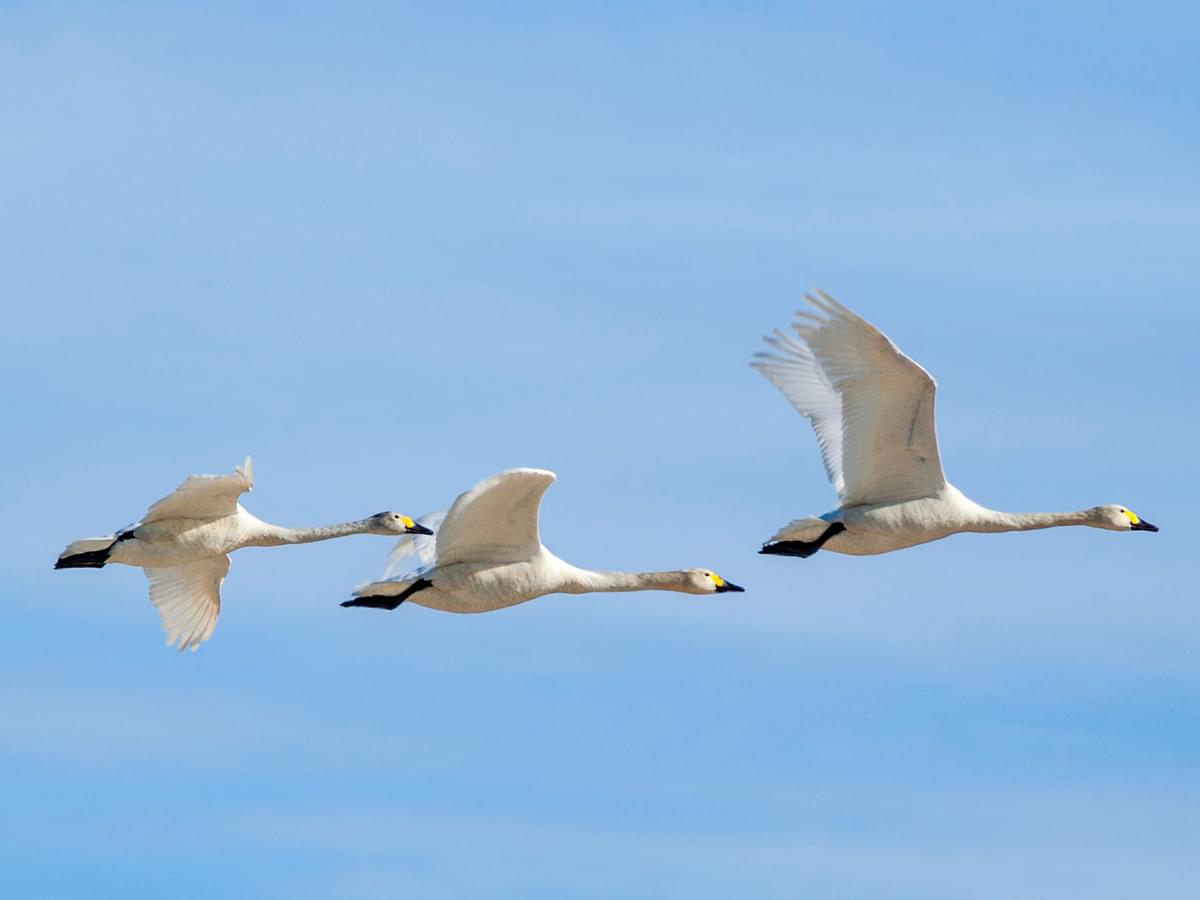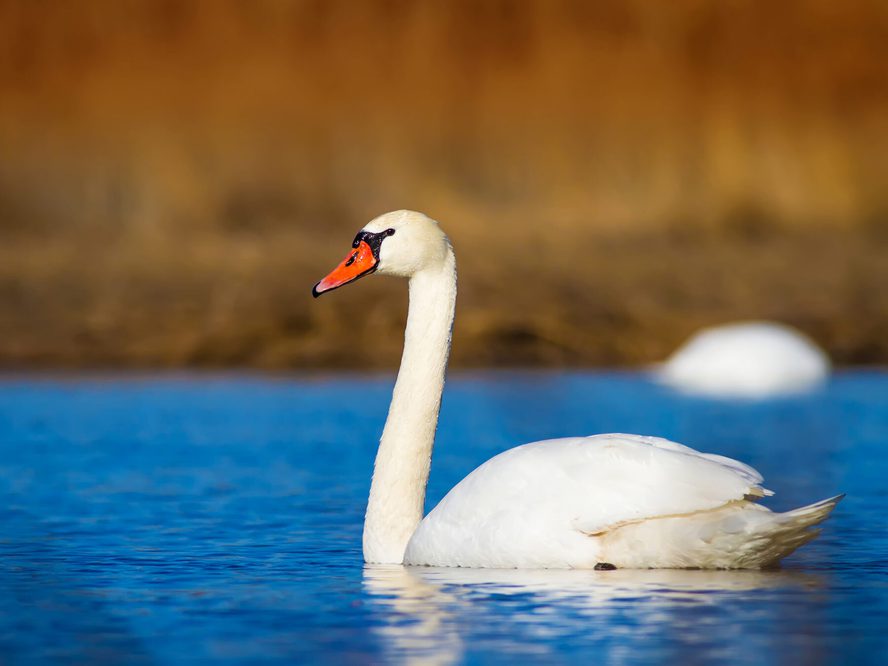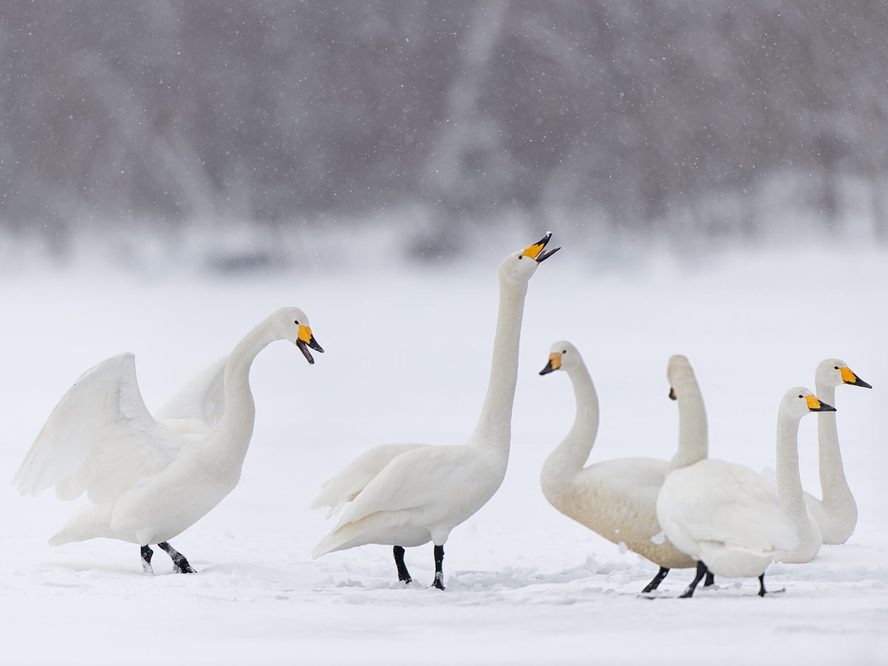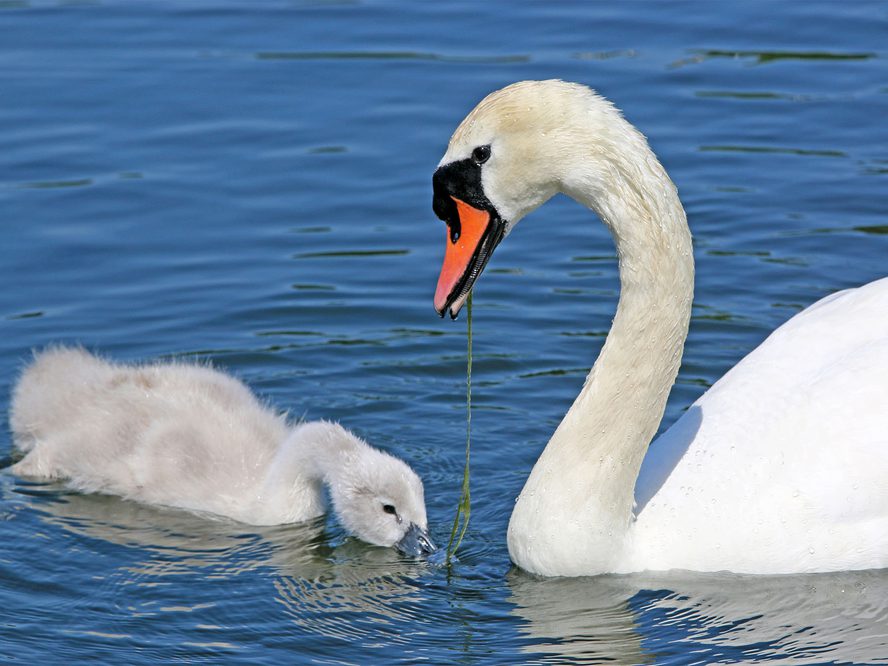Jump to Section
Do Swans Migrate? (All You Need To Know)
Last updated: 11 April 2022

There are six species of swans distributed throughout every continent except Africa and Antarctica. Swans are some of the most majestic and elegant birds around, and they’re also exceptionally large, strong flyers, so do swans migrate?
Swans are migratory in nature, but not all populations of swans migrate. Swan migration is often dictated by their exact location, food availability, and weather conditions. For example, swans from Canada and Northern Europe tend to head south in the winter, whereas populations in the USA and Western and Central Europe may or may not migrate at all.
In North America, the Trumpeter and Tundra swan usually migrate south into the USA from Canada and Alaska. The Whooper swan is widely distributed across Scandinavia and Russia, and they migrate to parts of Europe in the winter, including the UK. The UK's winter swan populations increase from migratory Bewick’s and Whooper swans migrating from Russia, Iceland, and Scandinavia.
Swan migration is sporadic, and not every species migrates. For example, Mute swans are largely sedentary. Even some Alaskan and Canadian swan populations decide to stay put in the winter rather than migrate.
Read on to learn more about the migratory behaviors of these majestic birds!

Trumpeter Swans usually migrate to the US from Canada and Alaska
What swans migrate?
There are six to seven species of swans, as sometimes, the Bewick’s swan is classified as its own species rather than as a subspecies of the Tundra swan. Of these six species, at least five migrate partially.
- Mute swan: The Mute swan is largely sedentary, but a few populations migrate. In the UK, most Mute swans are permanent residents. In Eastern Europe, e.g., around the Volga Delta, some populations move southwards towards Iran and the Middle East, though this depends on the weather. Mute swans introduced in the USA and Japan migrate only partially, flying along river deltas until they find food sources when their habitats are frozen over.
- Whooper swan: Whooper swans are largely migratory, moving from Iceland, Scandinavia and Russia into the UK, Ireland, Germany, Denmark, and the Netherlands. Some end up further south in Spain and the Mediterranean. Numbers of Whooper swans in the UK increase considerably in winter.
- Trumpeter swan: Many Alaskan and Canadian populations of Trumpeter swan migrate to interior states. Those in the Pacific Northwest are the most likely to migrate. For example, populations in Alaska, British Columbia, Oregon and Washington head down the coast and in-land. Trumpeter swans are most likely to migrate when rivers and lakes freeze over. They typically only fly as far as they need to find unfrozen water, up to around 1,000km.
- Tundra swan: Tundra swans from the upper reaches of Canada nearly always migrate. Migratory routes follow the Great Basin, Mississippi River, and Susquehanna River Valley in Pennsylvania. Many Pacific Northwestern populations winter in Oregon and California. The Bewick’s swan, a subspecies of the Tundra swan, migrates from the Russian tundra to parts of East Asia. Bewick’s swans are a winter visitor to the UK, migrating over from parts of upper Scandinavia and the west Russian tundra.
- Black-Necked swan: The Black-Necked swan of South America is largely sedentary, though they do disperse down rivers to seek food.
- Black swan: The Black swan of Australia and New Zealand are largely sedentary, though many migrate from north Australia to South Australia and Tasmania.

In the UK, the majority of Mute Swans are non-migratory
When do swans migrate?
In the Northern Hemisphere, swans migrate during winter. Trumpeter and Tundra swans in North America start migration as early as October or as late as January and February; it depends on the weather conditions. In Europe, the Whooper swan migrates in September and October.
In other parts of the world, e.g., South America, East Asia, and Australia, migration varies with weather conditions and frost. In very icy winters, some swan populations migrate further than they normally would, ending up in Iran and the Mediterranean.
Why do swans migrate?
Most species of swans are cold-hardy, hence why some populations choose to remain north, even in exceptionally cold temperatures. However, the principal motive behind their migration is food - swans migrate when their food sources ice over.
Oftentimes, swans will migrate only as far as they need to find unfrozen bodies of water. Their migrations may be staged throughout winter, heading south in increments as the temperature drops.

A flock of Tundra Swans in Eastern, NC
How far south do swans migrate?
Swans are strong flyers and capable migrants. Trumpeter and Tundra swans in North America can travel over 1,000km or more, though they often choose to migrate in stages. For example, Trumpeter swans breeding in Wisconsin and Iowa migrate to Illinois, Missouri, Indiana, and Arkansas, but may stop anywhere in between.
Whooper and Bewick’s swans in Europe similarly travel long distances. Whoopers from Iceland head to Ireland, Scotland, and England, a non-stop journey of around 1,000 miles. Bewick’s swans similarly head to the UK from the Russian tundra and Arctic.
Do swans migrate in flocks?
Swans migrate in small flocks and often fly in the customary “V” formation. Flocks often consist of single swans, mated pairs, and juveniles. Flocks of migrating Trumpeter swans usually contain 10 to 25 birds, whereas flocks of migrating Tundra swans can be as large as 100 birds.
Trumpeter and Whooper swans often migrate in small family groups, consisting of a few pairs and their young. This is one of the few times where swans are gregarious and cooperative - they’re very territorial during the breeding seasons.

A large flock of wintering Whooper Swans in Japan
Are all swans migratory?
All six species of swans are partially migratory, but many wild populations are sedentary. Mute swans in the UK stay in the UK all year round, and Trumpeter swans in North America don’t always migrate.
Black swans and Black-Necked swans usually don’t migrate far, if they migrate at all.
So, while swans are considered migratory birds, they’re pretty flexible. Migration is sometimes a necessity, e.g., if lakes and rivers are freezing over and preventing swans from feeding. But swans often migrate shorter distances out of preference more than anything else. This is particularly true of Black swans and Black-Necked swans.
Why do some swans not migrate?
If swans have an ample food supply in-situ, they may not need to migrate. Swans are hardy birds that can survive cold weather - they migrate in search of food rather than shelter.
Even the northernmost swans, such as the Trumpeters, Whoopers, Tundras, and Bewick’s don't always migrate. But, if their river and lakeside habitats freeze over, they’ll head south in quest of food.

Black Swans generally are resident, and don't tend to migrate
Where do swans go in winter?
Many northern populations of swans in Canada, Russia, Iceland and Scandinavia head south during winter. Their wintering grounds are often abundant in food - that’s why they migrate.
Most swans don’t travel too far - North European swans (Whoopers and Bewick’s) often migrate to the UK and Central Europe, whereas Canadian swans (Trumpeters and Tundras) migrate to much of the USA, both the coast and the interior.
Where do swans go in the summer?
Migratory swans return to their breeding grounds in early spring, long before summer starts.
Most swans will head back from their wintering grounds before March or April, which is when they’ll begin to breed. Migratory swans stay in their breeding grounds throughout summer before leaving again in winter.

Mute Swan swimming peacefully on the lake
Which swans migrate to the US?
Tundra and Trumpeter swans both migrate to the US from Canada.
Tundra swans live in the Arctic and the Subarctic and migrate through much of Canada, with western populations wintering in Washington, Oregon, and California. Central and eastern populations winter in Wisconsin, Minnesota, and North Dakota.
Trumpeter swans migrate all across Canada and the USA, with notable wintering populations found in Idaho, California, Nevada, Oregon, Utah, New Mexico, Colorado, and Arizona.
Do swans migrate in winter from the US?
No swans leave the US in winter. Swans are virtually absent from Central America. The Black-Necked swan of South America is a permanent resident of the continent.

A small flock of migrating Tundra Swans
Which swans migrate to the UK?
Whooper and Bewick’s swans both migrate to the UK. Bewick’s typically arrive from Northern Russia and Scandinavia, whereas Whoopers arrive from Iceland and Scandinavia.
These long-distance migrators travel thousands of miles, and complete much of their journey without stopping. For example, Iceland to Ireland is around 1,500km or 950 miles.

Bewick's Swan

Whooper Swan
Do swans migrate in winter from the UK?
The UK is home to three species of swan; the Whooper, Bewick’s, and Mute swan. The resident Mute swan rarely migrates and stays in the UK all year round. The Bewick’s swan is both a resident and a winter arrival from the Arctic. The Whooper swan is also a winter arrival from the Arctic and Northern Europe.
While some migratory swans use the UK as a staging post to head further south, the vast majority stay here during winter. Few swans leave the UK in winter. The UK climate is perfect for swans, which is why the UK is home to so many of them!
On this page
- What swans migrate?
- When do swans migrate?
- Why do swans migrate?
- How far south do swans migrate?
- Do swans migrate in flocks?
- Are all swans migratory?
- Why do some swans not migrate?
- Where do swans go in winter?
- Where do swans go in the summer?
- Which swans migrate to the US?
- Do swans migrate in winter from the US?
- Which swans migrate to the UK?
- Do swans migrate in winter from the UK?








